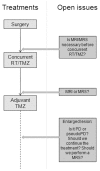Disease progression or pseudoprogression after concomitant radiochemotherapy treatment: pitfalls in neurooncology
- PMID: 18401015
- PMCID: PMC2563059
- DOI: 10.1215/15228517-2008-008
Disease progression or pseudoprogression after concomitant radiochemotherapy treatment: pitfalls in neurooncology
Abstract
Although radionecrosis has been exhaustively described in depth in the neurooncological literature, its diagnosis is still a challenging issue because its radiological pattern is frequently indistinguishable from that of tumor recurrence. This review discusses the causes of radionecrosis and the potential effect of adjuvant chemotherapy concomitant with radiotherapy on its rate and onset. The potential pitfalls in clinical studies attempting to make a differential diagnosis between radionecrosis and disease progression are also discussed.
Figures



References
-
- Stupp R, Mason WP, van den Bent MJ, et al. Radiotherapy plus concomitant and adjuvant temozolomide for glioblastoma. N Engl J Med. 2005;352:987–996. - PubMed
-
- Macdonald DR, Cascino TL, Schold SC, Jr, Cairncross JG. Response criteria for phase II studies of supratentorial malignant glioma. J Clin Oncol. 1990;8:1277–1280. - PubMed
-
- Hoffman WF, Levin VA, Wilson CB. Evaluation of malignant glioma patients during the postirradiation period. J Neurosurg. 1979;50:624–628. - PubMed
-
- Sheline GE, Wara WM, Smith V. Therapeutic irradiation and brain injury. Int J Radiat Oncol Biol Phys. 1980;6:1215–1228. - PubMed
-
- Pratt RA, Di Chiro G, Weed JC., Jr Cerebral necrosis following irradiation and chemotherapy for metastatic choriocarcinoma. Surg Neurol. 1977;7:117–120. - PubMed
Publication types
MeSH terms
LinkOut - more resources
Full Text Sources
Other Literature Sources
Medical

